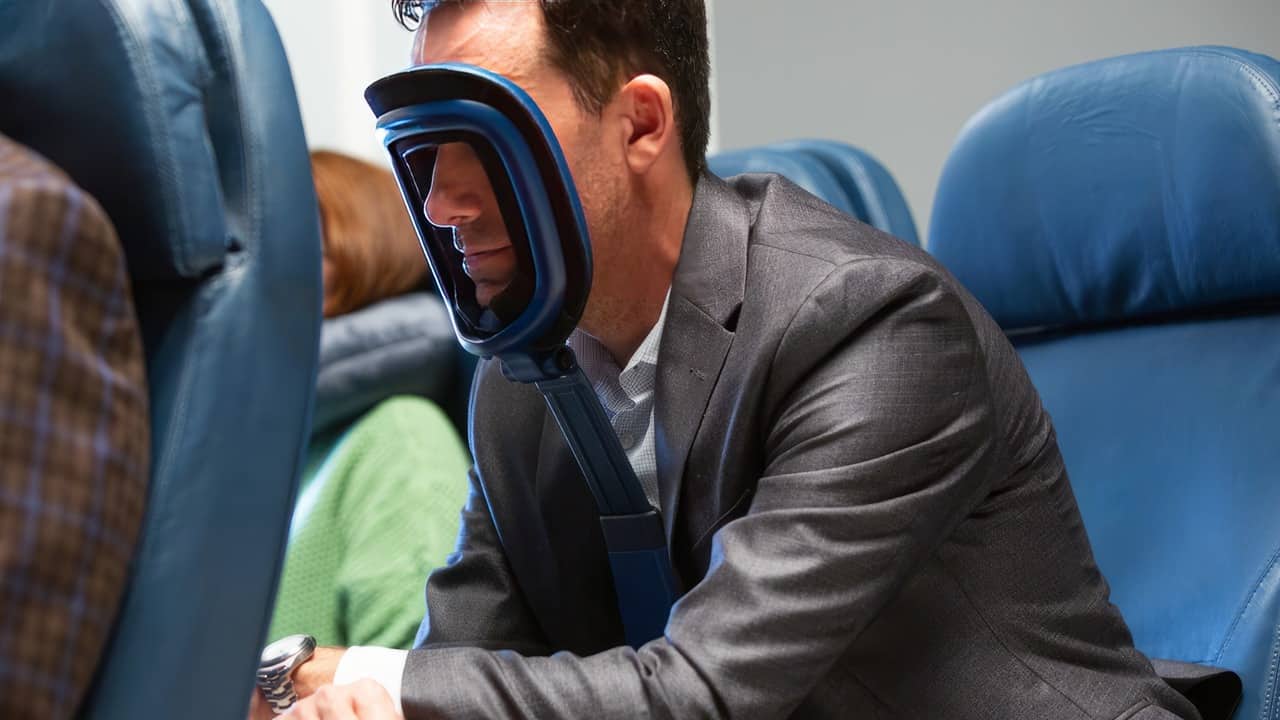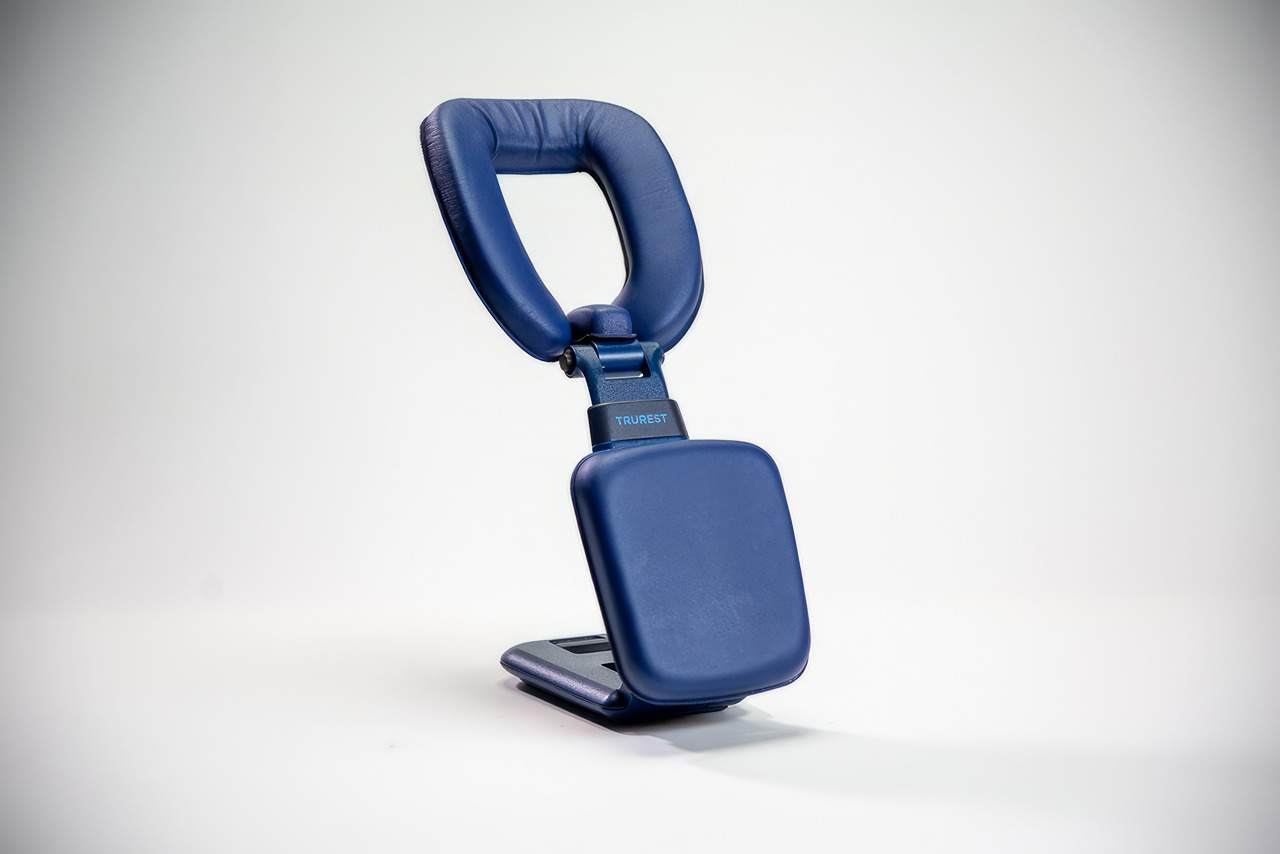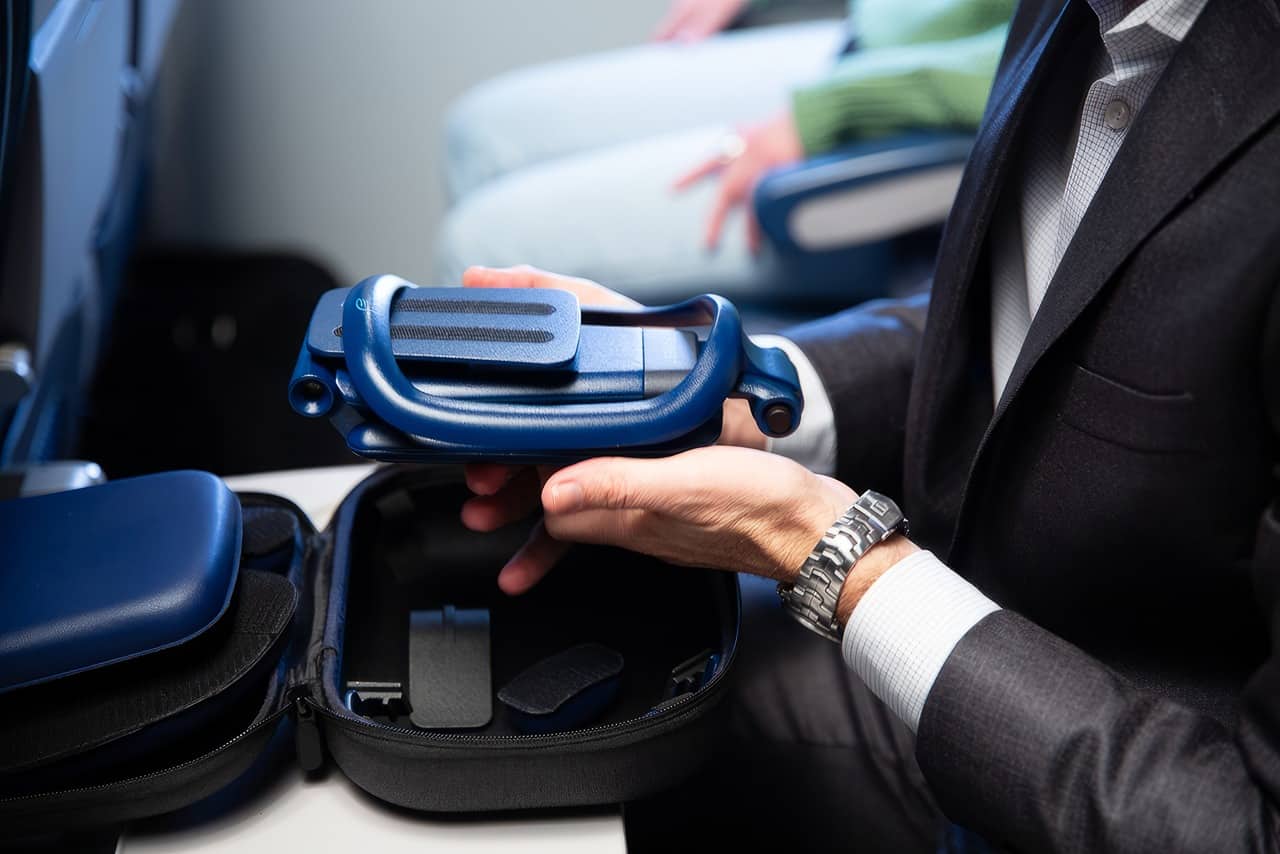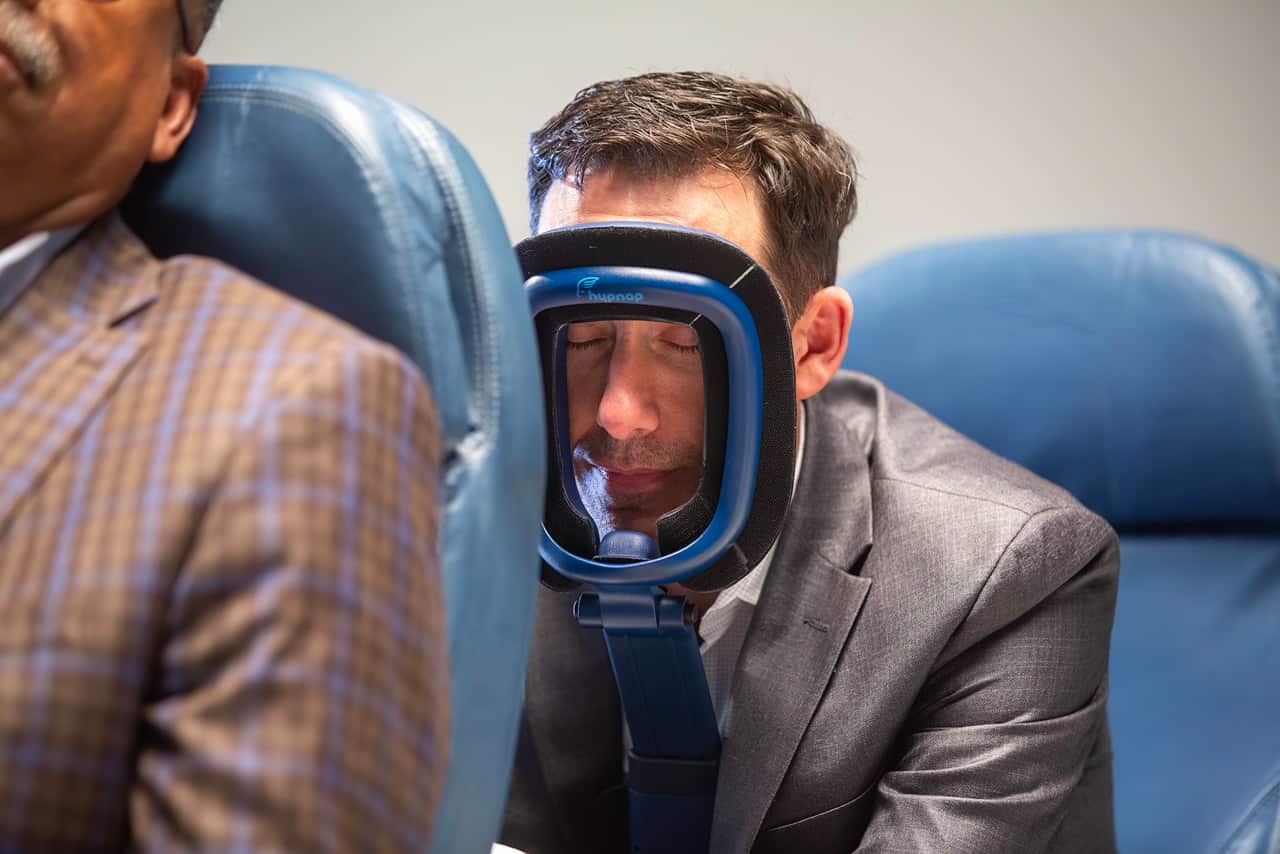In today’s fast-paced world, finding a moment of tranquility and rest can be challenging, especially during long flights. However, TruRest, a groundbreaking rest-aid solution, aims to change that narrative. Designed to provide ultimate comfort and support, TruRest offers a unique approach to sleep and relaxation while in the air.
In this exclusive Q&A session with Chloe and Darryl, the CEO and COO of TruRest, we delve into the innovative features, design process, and the significant impact TruRest has on enhancing sleep quality, physical health, and overall well-being. Join us as we explore the future of sleep technology and how TruRest is reshaping the way we rest on flights.
An Interview With Chloe and Darryl, the CEO and COO of TruRest

Unfinished Man: TruRest has been described as a “forward-leaning rest-aid solution.” Can you share some unique features or innovations that set TruRest apart from other sleep aids on the market?
Chloe and Darryl: On a flight, many people like to lean forward and rest their heads against their folded arms or a backpack on the tray table. To rest leaning forward with your chin on your hand while your elbow rests on a table is a natural and instinctive position for humans. TruRest takes advantage of that comfortable position. I think the key differentiator with our product compared to other rest aid solutions is the chest support. What we found in our testing is that the chest support – along with the head support, is key to comfort. The full upper body needs to be supported for real comfort. There are rest aids that support the head and neck, such as neck pillows and the like, but no other product besides our product TruRest supports the full upper body (both the head/neck and chest), which relieves both back and neck/shoulder strain.
When we sit upright, our back and neck muscles are doing a lot of work to hold us upright. This is not conducive to comfort or deep rest and sleep. We want relief from that muscle strain. When you are using a neck pillow or any other product that only supports your neck and head, your back muscles are still going to be straining to hold you upright. There are some products out there that allow you to lean forward – for example, inflatable rest aids that have a face support with an opening for breathing. However, those rest aids don’t have chest support or don’t adequately support your chest, so you will still experience back strain. Also, those products are not adjustable like TruRest. In addition, many neck pillows are actually quite bulky. TruRest is very sleek, compact, and lightweight. It folds down to the footprint of an iPad with a 4-inch thickness. Many neck pillows and other rest aids have a tacky appearance. We paid a lot of attention to the design. TruRest has a sleek and modern design that looks great.
Many people struggle with achieving a good night’s sleep due to various factors such as stress and environmental disturbances. How does TruRest address these challenges and provide a truly restful experience?
As we did more research on the forward-leaning position, we found that there were health benefits. Doctors often proscribe this position to COPD patients so that they can breathe easier. After a race, people often lean forward to catch their breath. TruRest facilitates the forward leaning position, which allows you to breathe deeper, easier, and more efficiently, which promotes the relaxation response. When you use deep, diaphragmatic breathing, you are naturally stimulating the Vagus nerve, which promotes relaxation. The Vagus nerve works in conjunction with the parasympathetic nervous system, which is responsible for calming and decelerating our system, for example, slowing the heart rate and breathing, lowering blood pressure, and relaxing the muscles. Also, when we enter the REM sleep stage (the deepest sleep stage), our muscles go into a state of paralysis. This is why it’s almost impossible to enter the REM sleep stage when you’re seated upright because your muscles need to do work and keep engaged in holding your body upright. They can’t go into that paralysis state that is required for REM sleep. So, any sleep that you are getting when seated upright is often light and ineffective. When you use TruRest, you have a much better chance of entering the deep REM sleep stage.
In a world where technology often disrupts sleep patterns, how does TruRest leverage technology to enhance sleep rather than hinder it?
TruRest is a gadget. However, when I think of technology I think electronics, and there are no electronics installed within TruRest currently. However, it is something we are considering for the future – for example, sleep trackers, chargers, and face massage. Our aim for any technology that we do install will be to enhance rather than hinder rest and sleep.
The TruRest campaign on Kickstarter was a huge success, surpassing its funding goal. What do you believe attracted backers to support TruRest, and how will their contributions help bring this innovative product to the market?
First of all, we are very grateful to all of our backers for supporting our campaign. We could not have reached and surpassed our goal without you, so thank you! Being uncomfortable and not being able to sleep is a real pain point for airplane passengers – especially frequent flyers and those flying in coach on long-haul and red-eye flights. Since the neck pillow came out in the 1970s, there hasn’t been much innovation in this area. Current rest aids are variations of the neck pillow, so it’s the same ineffective solution. We’ve identified the problem as being that you aren’t going to get quality rest if you’re seated upright. So, any gadget that keeps you in that upright position isn’t going to help you. TruRest offers something truly different. We’re raising money for tooling and production costs, so all of the contributions that our backers make will go towards manufacturing and getting the product into their hands as soon as possible.
The TruRest campaign offers backers the opportunity to become part of the product development process. How important is it for you to involve consumers in the creation and refinement of TruRest, and how does their input shape the final product?
Consumer input is extremely important! We’re trying to solve a problem for people, so those people and their needs, desires, and concerns have to be the focus of our design development. We started with our initial idea and tested it out with our team and our friends and family and then we expanded our testing to include over 60 independent testers for a formal test. We collected detailed data from them that informed our design. In reality, we’ve tested our product informally with hundreds of people, and this has also informed our design. We are continually collecting feedback to see how we can improve TruRest and the experience of our consumers.
TruRest has been praised for its sleek design and ergonomic features. Can you talk about the design process behind TruRest and how aesthetics and functionality were balanced to create a truly desirable product?
We encountered many challenges while developing TruRest. It was very difficult to balance comfort with compactness. Making it intuitive and easy to use was another added challenge, and of course, we also wanted to make TruRest look good. We started out testing a tabletop massage rest aid that massage therapists use to convert a standard table and chair into a massage chair. Those devices offer a lot of comforts because they have a lot of padding, but obviously, we had to create something that was compact and portable for airplane passengers, so we had to shed that bulk but still balance comfort.
When we first started developing TruRest’s design, we realized that we had a big responsibility to make sure that our product supported the body correctly and was safe for people to use. We wanted to create a product that not only didn’t do harm but really benefited people and accomplished the goal that we set out to accomplish with the product – to make people more comfortable. That’s when we started consulting with health professionals – doctors, physical therapists, chiropractors, etc. With each version of our prototype, we got feedback from health professionals, and then we’d tweak it and alter the design based on their suggestions. We also realized that everyone has different bodies and sometimes different conceptions of what is comfortable. For example, some people like the chest cushion to be positioned on the upper part of their chest, and some prefer it on the lower part of their chest. So, we had to make our product highly adjustable so that people could customize it to what they felt was comfortable. We spent a lot of time refining the design of the adjustment features so that it was intuitive for people to use. Being frequent flyers and road warriors, we started out designing for what we longed for on a flight, and then we collected feedback from over 60 testers of different heights, shapes, and sizes to better understand the needs and desires of a wide variety of people. At all times, we used the empathetic design approach and did extensive testing to observe and collect data on how people would use TruRest, the problems that they would encounter, and what their needs were.
I had a vision for what I wanted TruRest to look like. I wanted it to look like a piece of sleek modern portable furniture. We and our designers were inspired by Herman Miller’s Aeron chair and Beats headphones. Most travel rest aids are tacky looking with little to no emphasis on design. We wanted TruRest to have a sleek and modern look – a gadget that people would be proud to use.
Sleep is a vital component of overall well-being. How does TruRest contribute to promoting not just better sleep but also better physical and mental health?
Sleep is very important to our health. Not getting enough sleep is linked with many chronic diseases and conditions, such as type 2 diabetes, heart disease, obesity, and depression. There’s a sleep epidemic in the US and really, worldwide right now. People are overworked and sleep deprived. Anything that can help you get more sleep, be more productive, and anything that’s going to help reduce pain and make you more comfortable is going to add huge benefits to your life and well-being. Often, when business travelers arrive at their destinations, they need to hit the ground running and be ready to work upon arrival. If you’re Jetlagged or just got off a red-eye and couldn’t sleep, you’re going to feel awful and not be at your best. So TruRest can help you be more productive. Many leisure travelers also want to hit the ground running when they arrive at their destinations so that they can take full advantage of the time that they have. TruRest can help you make the most out of your trip.
With the rise of mindfulness and wellness practices, TruRest seems to align with the growing interest in self-care. How do you see TruRest fitting into the broader landscape of wellness products and services?
Getting proper sleep is one of the best things that you can do for your health and wellness. Fortunately, there is more and more awareness around this. We’d love TruRest to be available to every passenger on their airplane flight, and we’d like to explore partnerships with airlines. The airlines have rolled out some products to address comfort, health, and wellness for passengers, but we’d like to be part of a broader approach. We think this could benefit both customers and the airlines. We are also exploring other potential markets for TruRest – in the massage therapy and spa industry and in the medical industry. TruRest is also great for people who do precision work with their hands and can save them from back and neck strain.
Sleep aids have been around for a long time, but TruRest aims to revolutionize the way we approach rest and relaxation. How do you envision TruRest reshaping the industry and influencing future developments in sleep technology?
When people think about sleeping and resting, they often think about leaning back or lying down. Lying down is the best option, but sometimes people need to rest and sleep, and that option isn’t available. People don’t often think of leaning forward, but this is actually a natural position and gesture for humans. As I mentioned before, resting leaning forward with your chin on your hand while your elbow rests on a table is a natural and instinctive position for humans. Many people like to lean forward and rest their heads against their folded arms or a backpack on the tray table. Also, when you get a massage, you are in the prone position face down. If people can sleep and rest this way on an airplane flight, it would dramatically reshape people’s use of airplane cabin space. There have been fights on airplanes due to passengers reclining their seats. If people use TruRest, there is no need to recline your seat and disturb the passenger behind you. TruRest could really change the atmosphere on a flight from the tense environment that currently exists to one of calm and peace. That’s better for everyone. Also, some people have health conditions that prevent them from being able to lie down. TruRest can provide a great solution for those people when they’re on the go.
TruRest has garnered significant attention and positive feedback from early users. Can you share any inspiring stories or testimonials that highlight the impact TruRest has had on individuals’ lives?
Many of our testers have been business travelers who fly frequently, and they told us that TruRest would make a significant impact on their travel experience and their ability to be comfortable on a flight and thus significantly enhance their lives. One tester told us that he arrived from his red-eye flight to his destination and, for the first time, didn’t feel awful. TruRest made his flight a tolerable experience. We’ll take that! Other testers have told us that even just being able to rest in an alternative position for a couple of hours made a big impact on their comfort and their experience on their airplane flight. A couple of office workers told us they used TruRest to take quick cat naps at the office, and it helped them to feel better and thus be more productive at work. We had one young tester tell us they’d like to use it in one of their university classes. We don’t recommend that!
TruRest encourages users to take a proactive role in prioritizing their rest. How does the product empower individuals to make positive changes in their sleep habits and overall well-being?
Airplane passengers are often not used to getting any sleep on their flights, so the ability to finally be comfortable and get quality rest on their airplane flights will make a significant impact on their health – especially frequent flyers. This can help them be more productive and make the most out of their time when they arrive at their destinations. Research shows that even taking a 20-minute power nap can help you be more productive and make you feel better throughout the day. If office workers have a tool to help them facilitate more rest, it can really enhance their health and wellness.
As CEO and COO of TruRest, what challenges did you face in bringing this innovative product to market, and how did you overcome them?
We faced many challenges as we took TruRest from idea to reality. Some of those challenges lie in the design process itself and having to balance comfort with compactness in the design. We also had to consider reducing the costs to produce TruRest as it consists of many parts. Because TruRest is so new and different, we face the challenge of convincing people to try something new.
TruRest combines cutting-edge technology with the fundamental need for rest. How do you strike a balance between embracing innovation and staying true to the essence of sleep and relaxation?
In this case, staying true to the essence of sleep and relaxation required something innovative because it’s so difficult to get quality sleep and comfort on an airplane flight! We needed to develop something completely new in order to provide an effective solution. That being said, resting in the lean forward position is new for some people, so we are presented with the task of encouraging people to try something new because it may not be the first thing they think of when it comes to the thought of sleep and relaxation. Our goal was to make TruRest easy to use and beautifully designed so that people felt invited to use it and it felt as welcoming as possible.
Learn More About TruRest


We extend our gratitude to Chloe and Darryl of TruRest for sharing their insights and shedding light on the remarkable benefits of their product. TruRest’s commitment to revolutionizing the way we approach rest and relaxation on flights has garnered significant attention and positive feedback from early users. By combining ergonomic design, intuitive adjustments, and a focus on supporting the body correctly, TruRest has set a new standard for sleep aids. As we look ahead, it is evident that TruRest’s innovation and dedication to improving sleep quality will continue to shape the industry and inspire future developments in sleep technology. We invite our readers to discover the transformative potential of TruRest and embark on a journey to more restful skies.

